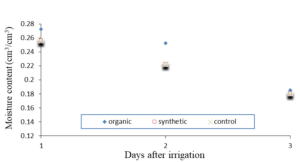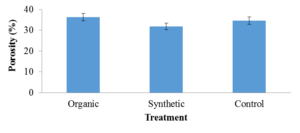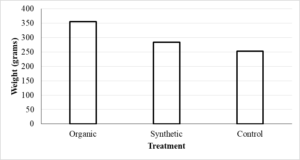Publication Information
Frequency: Continuous
Format: PDF and HTML
Versions: Online (Open Access)
Year first Published: 2019
Language: English
| Journal Menu |
| Editorial Board |
| Reviewer Board |
| Articles |
| Open Access |
| Special Issue Proposals |
| Guidelines for Authors |
| Guidelines for Editors |
| Guidelines for Reviewers |
| Membership |
| Fee and Guidelines |
 |
The Effects of Organic Liquid Fertilizer (Vegetable Waste) on Moisture Retention, Soil Physical Properties and Yield of Lettuce (Lactuca Sativa L.) Grown in the Malkerns Area, a Region in the Kingdom of Eswatini.
Dlamini M V1*, Mukabwe W O1 and Sibandze N N1
1Lecturer in the Dept. of Agricultural and Biosystems Engineering, University of Eswatini, Faculty of Agriculture, Private Bag, Luyengo, Eswatini
Received Date: April 21, 2021; Accepted Date: April 29, 2021; Published Date: May 06, 2021;
*Corresponding author: Dlamini M V, Lecturer in the Dept. of Agricultural and Biosystems Engineering, University of Eswatini, Faculty of Agriculture, Private Bag, Luyengo, Eswatini. Email: musavd@gmail.com
Citation: Dlamini M V, Mukabwe W O, Sibandze N N (2021) The effects of organic liquid fertilizer (Vegetable waste) on moisture retention, soil physical properties and yield of lettuce (Lactuca sativa L.) Grown in the malkerns area, a region in the kingdom of eswatini. Adv Agri Horti and Ento: AAHE-152.
DOI: 10.37722/AAHAE.2021502
Abstract
The main aim of this study was to investigate the effect of organic food waste on the condition of soil and the yield of vegetables. The experiment was a randomized block design with N:P:K at ratio of 2:3:2(37) inorganic fertilizer, organic fertilizer (vegetable food waste) and no fertilizer as the three treatments using no fertilizer as a control. There were three replications per treatment. The vegetable food waste was processed in a closed container along with addition of stillage and sugar in anaerobic conditions for 3 weeks. The vegetable food waste liquid fertilizer was analysed and the NPK values were found to be 0.83 %, 16.5 mg/kg, 20.62 cmol/kg, respectively. After application of treatments in the soil, the results of the study showed that vegetable waste had the highest yield per head (355.5 g) followed by synthetic fertilizer and no fertilizer treatment (control) with 283.2 g, and 253.1 g, respectively. Similarly, vegetable food waste had the higher moisture holding capacity of 0.237 cm3/cm3 while synthetic fertilizer and the control both were 0.139 cm3/cm3. The results obtained from the study showed that liquid vegetable food waste fertilizer can be used as an alternative to synthetic fertilizer to increase crop yield and improve soil physical properties while reducing the negative impact of synthetic fertilizers on the environment as well as the environmental effect of disposing vegetable food waste in landfills.
Keywords: Lettuce; Liquid Fertilizer; Soil Properties; Vegetable Waste; Yield
Introduction
Fertilizer (inorganic / synthetic) is a substance added to the soil to improve plant growth and yield (Khairnar and Nair, 2019). These fertilizers contain a combination of chemicals and minerals that were produced artificially in a refinery, and it offers farmers a more reliable form of plant nutrients. The nutrient levels in these fertilizers are precisely calculated to be consistent, and hence it has won the hearts of many farmers. Modern synthetic fertilizers are composed of mainly nitrogen, phosphorus, and potassium with other secondary micronutrients added. The long term use of these fertilizers have irked environmentalist, in that they also affect soils in ways that can harm plants, animals, and the environment (Ogbodo, 2013; Khairnar and Nair, 2019) if the fertilizer is not applied correctly and in the right quantities. The poor farm management technique and improper use of these agrochemicals has also resulted in both soil quality and environmental degradation (Setboonsarng and Gilman, 1999).
History tells us that ancient farmers knew that the first yields on a plot of land were much higher than those of subsequent years, adding the desire to farmers to always want to have fresh uncultivated land, making them live like nomads. When land became limiting, farmers began adding various products (organic materials) to the soil, like ashes, various animal excrements, sea shells, vegetable waste, trash, and growing leguminous crops before cultivating the major crop. Many researchers have noted that solid organic fertilizers are taken up slowly by many plants compared to liquid organic fertilizers (Johnson et al., 2012; Darwin et al., 2019; Fahrurrozi et al., 2016). The function of liquid organic fertilizer is similar to that of solid fertilizers (Hartz et al., 2010; Mostafazadeh‑Fard et al., 2019). The researchers stated that nitrogen derived from liquid organic fertilizers was more readily available and the nitrification process took place faster. Hasarin and Viyada (2008) observed that liquid biofertilizer contributes increased microorganisms in the soil. There are different types of biofertilizer available and their differences are mainly in the raw materials used, forms of utilization and the sources of microorganisms.
Peng and Pivato (2019) noted that processing of vegetable food waste improved soil nutrients availability and content, and thereby increased the agricultural value of the waste when used as fertilizers, while contributing to a more bio-based circular economy. Liquid organic matter, like compost, had been shown to increase the water holding capacity of the soil after seven years of compost applications (Miller et. al, 2014). In an experiment using stillage (Dlamini et al., 2019) the yields of butternut squash were better than in conventional fertilizer plots.
The anaerobic respiration process (fermentation) is one of the biochemical processes that could be used to extract the organic compounds contained in food waste with the help of microorganisms (Sari, 2009; Akib and Setiawatu, 2017). The fermentation process is also affected by several factors including: pH, time of operation, nutrient, temperature, and sugar content. The use of waste as nontraditional organomineral fertilizers can significantly reduce the costs associated with the acquisition of industrial mineral fertilizers and increase the yield of many crops while improving the environmental situation (Kabaloev et al., 2018).
Materials and Methods
In order to test the response of lettuce (Lactuca sativa L.) to vegetable waste liquid fertilizer, a field plot experiment using a randomized block design was established in the Agricultural and Biosystems Engineering farm of the University of Eswatini at Luyengo campus. The farm is located in the Middleveld of Eswatini at 21034′S and 31012′E at an altitude of about 730 m above sea level (Dlamini and Khumalo, 2019). The average maximum temperature is 27 OC in summer and 15 0C in winter. The area receives an average of 993 mm of precipitation annually, most falling in the summer months (October to March). The soils where the experiment was conducted are sandy loam. The experiment consisted of three treatments including the control, each replicated three times. Treatment 1 (T1) was fertilized with inorganic fertilizer (2:3:2 (37)), treatment 2 (T2) fertilized with organic liquid waste fertilizer, and treatment 3 (T3) the control not fertilized. A total of 30 lettuce plants were planted in each treatment.
Transplanting
Seedlings were obtained from Vickery Seedlings, a local company that supply ready to be planted seedling located at Malkerns. They were planted at a spacing of 25 cm between plants and 30 cm between rows, at a depth of 2.5 cm. The liquid organic fertilizer was applied to plots seven (7) days before transplanting. Basal fertilizer dressing was done using N:P:K; 2:3:2 (37) fertilizer at a rate of 300 kg/ha as per the soil test requirement. Top dressing was done using limestone ammonium nitrate (LAN – 28% N) at a rate of 10 g per plant three weeks after transplanting. Weeding was done by hand using a hand hoe and no herbicides were applied.
Water Management
The daily crop water requirements of lettuce were determined using the FAO 56 Penman –Monteith equation (Allen et al., 1998). The irrigation interval was two (2) days, except on days in which soil moisture content measurements were taken. The soil moisture characteristics of the soil are summarized on (Table 1).
| Saturation | Field Capacity | Wilting Point | Bulk Density (g/cm3) |
| 0.65 | 0.35 | 0.16 | 1.47 |
Table 1: Soil moisture characteristics of the soil at the experiment site in cm3/cm3.
A soil moisture meter was used to check the water content of the treatments after irrigation and before the next irrigation.
Drip irrigation was used as the best method for water application, with the gross amount of water applied being 4.8 mm per irrigation per day.
Self-compensating, 16 mm dripper lines with emitter spacing of 0.30 m along the lateral were used, each emitter delivering 2.0 liters per hour. Irrigation was done twice a day, in the morning and in the afternoon for thirty minutes each.
Soil Analysis
Soil samples were collected from the plots before planting for nutrient analysis using a zigzag method to determine the amount of nitrogen (N), phosphorus (P), potassium (K) and pH. The samples were analysed at the Soil Chemistry laboratory of the University of Eswatini (Table 2).
| Parameter | Amount |
| Nitrogen (N) | 0.15% |
| Potassium (K) | 0.31 cmol/kg |
| Phosphorus (P) | 0.41 mg/kg |
| pH | 5.7 |
Table 2: Nutrient content of the soil before planting.
Measured Parameters
Parameters measured included the soil moisture content at 4 weeks and 6 weeks after planting, the soil porosity (after harvesting), the lettuce fresh and oven dry mass (grams) and the changes in soil nutrient content before and after the application of the treatments.
Results and Discussion
Soil Moisture Content
The soil moisture content was measured for three days after irrigation at 4 weeks and 6 weeks after planting using a moisture meter. The results are shown in (figure 1 and 2).

Figure 1: Graph showing the change in moisture content with time for the different treatments at 4 weeks.
The moisture content was higher in the liquid fertilizer treatment for the days as compared to the organic fertilizer treatment and the control. There were no noticeable differences between the organic fertilizer treatment and the control.
Surprisingly at week 6, the liquid organic fertilizer treatment had significantly higher moisture content than the organic fertilizer and the control treatments. This agrees with the observation of Dlamini et al. (2019) and Miguel et al (2014) who noted that stillage (a form of organic fertilizer) improved the soil chemical and physical properties resulting in the increased yield of the planted crop.

Figure 2: Graph showing the change in moisture content with time for the different treatments at 6 weeks.
Soil Porosity
The porosity of the soil was measured from all the treatments after harvesting (Fig 3). The liquid fertilizer treatment showed a higher value than both the synthetic fertilizer and control treatments. The synthetic fertilizer treatment had a lower porosity than the control. The liquid organic fertilizers seem to improve the water holding capacity of the soil, but the differences were not significantly different.

Figure 3: Graph showing the variation of porosity with treatment (means with the same letter are not significantly different from each other, P < 0.05).
These results are in agreement with those obtained by Garg et al. (2005) who demonstrated that soils treated with agricultural waste had reduced bulk density and increased saturated hydraulic conductivity and moisture retention capacity.
Lettuce Yield
The mean yields per treatment are shown in (figure 4). The highest yield of lettuce was obtained in treatments of liquid organic fertilizer followed by the synthetic fertilizer and the least the control. The results corroborated with the finding of Waleed et al. (2020) who did experiments on lettuce and Dlamini et al. (2019) who experimented on butternut squash.

Figure 4: The average lettuce head weight per treatment.
In an experiment by Hossain and Ryu (2017) they observed that the improved yield of lettuce on organic fertilizer was attributed to improvements in the water holding capacity, microbial activity as well as the physicochemical properties of the soil. Krishna et al., (2004) noted that organic fertilizers has the ability to transform electrochemical properties of in particular acidic soils resulting in improved base retention and increased soil pH.
Soil nutrient content
An analysis of the soil nutrient content showed an increase in nitrogen, phosphorus and potassium in the liquid organic fertilizer treatments compared to the synthetic fertilizer treatments. This validates the use of liquid organic fertilizer in cases where the cost of synthetic fertilizer could not be afforded.
Conclusion
The result of the experiment indicated that liquid vegetable food waste fertilizer has an effect on the soil physical properties (moisture holding capacity and porosity). The soil moisture content of the soil with vegetable food waste (3 days after irrigating) increased from 0.139 cm3/cm3 to 0.237 cm3/cm3 while that of synthetic fertilizer and the control remained at 0.139 cm3/cm3,. The porosity from the 3 treatments, organic fertilizer, synthetic fertilizer and the control were 36.3%, 31.9% and 34.6%, respectively.
The highest yield of lettuce was obtained from vegetable food waste fertilizer followed by synthetic fertilizer and the minimum yield was obtained by control treatment (no chemical applied). The average yield from the three treatments; organic fertilizer, synthetic fertilizer and the control were 355.5 g, 283.2 g and 253.1 g, respectively. The study revealed that the nutrient value of ordinary vegetable food waste is converted into a highly useful product as liquid fertilizer. This technique can empower and is expected to slightly ease the burden on the farmers, economical wise.
References
- Muh Akhsan Akib, Henny Setiawatu (2017) Fermentation of Whey Waste as Organic Liquid Fertilizer “PUCAFU”. Agrotech Journal (ATJ). Vol 2(2) Nov 2017:7-13. ISSN: 2548-5121.
- Darwin Habinsaran Pangaribuan, Sarno, Kus Hendarto, Ajeng Kusuma Darma, Tika Aprillia et al. (2019) Liquid Organic Fertilizer from Plant Extracts Improves the Growth, Yield and Quality of Sweet Corn (Zea mays L. var. saccharata). Pertanika J. Trop. Agric. Sc. 42:1157-1166.
- Dlamini M V, Khumalo T (2019) Comparing the performance of a home-made bottle drip to a commercial drip system in the production of lettuce (Lactucasativa L.). International Journal of Environmental & Agriculture Research (IJOEAR) ISSN:[2454-1850]. 5:1-4.
- Dlamini M V, Manyatsi A M, Simelane S B (2019). The effect of sugarcane stillage on the yield of butternut squash (Cucurbita moschata) grown at Tambankulu Estates, a semi-arid region in the north eastern Lowveld of Eswatini. International Journal of Environment, Agriculture and Biotechnology (IJEAB). 4:1315-1319.
- Fahrurrozi, Muktamar Z, Dwatmadji, Setyowati N, Sudjatmiko S, et al. (2016) Growth and yield responses of three sweet corn (Zea mays var. saccharata) varieties to local-based liquid organic fertilizer. International Journal on Advanced Science Engineering and Information Technology, 6:319-323.
- Garg RN, Pathak H, Das DK, Tomar RK (2005) Use of fly ash and biogas slurry for improving wheat yield and physical properties of the soil. Environ Monit Assess 107:1-9.
- Hartz T K, Smith R, Gaskell M (2010). Nitrogen availability from liquid organic fertilizers. HortTechnology, 20:169-172.
- Hasarin N, Viyada K (2008) The Study of Shelf Life for Liquid Biofertilizer from Vegetable Waste. AU J.T. 11:204-208.
- Hossain MB, Ryu KS (2017) Effects of organic and inorganic fertilizers on lettuce (Lactuca sativa L.) and soil properties. SAARC Journal of Agriculture, 15:93-102.
- Johnson H J, Colquhoun J B, Bussan A J, Laboski C A M (2012) Estimating nitrogen mineralization of composted poultry manure, organic fertilizers, and green manure crops for organic sweet corn production on a sandy soil under laboratory conditions. HortTechnology, 22:37-43.
- Kabaloev TX, S C Dzanagov, S A Bekuzarova, I M Subbotin, I K Esenov (2018) Use of Distillery Waste as a Fertilizer. J. Pharm. Sci. & Res. 10:2314-2316.
- Krishna GM, Arum KM, Kuntal MH, Kali KB, Prabir KG et al. (2004) Rice residue-management options and effects on soil properties and crop productivity. Food, Agriculture and Environment, 2:224-231.
- Mayur Dattatray Khairnar, Sagar Screekumar Nair (2019) Study of eggshell and fruit peels as fertilizer. Proceeding of the international conference on sustainable development (ICSD 2019). 25-27.
- Miller JJ, Beasley BW, Drury CF, Larney FJ, Hao X (2014) Nitrogen Budgets Following Land Application of Composted or Stockpiled Feedlot Manure Containing Wood-Chips or Straw Bedding to Barley Silage for 12 Years. Compost Science & Utilization, 22:57-67.
- Miguel A M, Rossetto R, Mutton MJR (2014) Agricultural use of stillage. Sugarcane Bioethanol – R&D for Productivity and Sustainability. 423-440.
- Mostafazadeh‑Fard S, Zohrab Samani, Paola Bandini (2019) Production of Liquid Organic Fertilizer Through Anaerobic Digestion of Grass Clippings. Waste Biomass Valor. 10:771-781.
- Ogbodo E N (2013) Impact of the use of Inorganic Fertilizers to the Soils of the Ebony State Agro-Ecology, South East Nigeria. Journal of Environment and Earth Science.
- Peng W, Pivato A (2019) Sustainable Management of Digestate from the Organic Fraction of Municipal Solid Waste and Vegetable food waste under the Concepts of Back to Earth Alternatives and Circular Economy. Waste and Biomass Valorization. 10:465-481.
- Sari RPP (2009) Pembuatan Etanol dari Nira Sorgum dengan Proses Fermentasi. Seminar of Skripsi, Department of Chemistry Engineering. Diponegoro University, Semarang. www.undip.ac.id. Diakses 13 April 2013.
- Setboonsarng S, Gilman J (1999) Alternative agriculture in Thailand and Japan.
- Waleed A, Shiho K, Riho I, Ahmad M, Ryota K (2020) Agricultural Utilization of Unused Resources: Liquid Vegetable food waste Material as a New Source of Plant Growth-Promoting Microbes. 1-14.